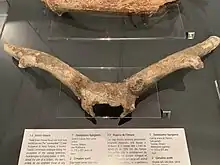Torontoceros
Torontoceros ("horn of Toronto") was an extinct genus of deer, nicknamed the Toronto subway deer. It lived in the Late Pleistocene (around 12,000 - 11,000 years ago) in Ontario while likely being native elsewhere.[1] The sole species is T. hypogaeus.
| Torontoceros Temporal range: Late Pleistocene ~ | |
|---|---|
| Scientific classification | |
| Domain: | Eukaryota |
| Kingdom: | Animalia |
| Phylum: | Chordata |
| Class: | Mammalia |
| Order: | Artiodactyla |
| Family: | Cervidae |
| Subfamily: | Capreolinae |
| Genus: | †Torontoceros Churcher and Peterson, 1982 |
| Type species | |
| †Torontoceros hypogaeus Churcher and Peterson, 1982 | |
Discovery
Fossils of Torontoceros were first unearthed in 1977 from Late Pleistocene deposits exposed by excavations brought about by the construction of the Bloor-Danforth subway line in Toronto, Canada, the sediments dating to the Late Pleistocene. It was later described by Canadian paleontologists C. S. Churcher and R. L. Peterson in 1982 as a new genus and species of cervid after the specimen had been donated to the Royal Ontario Museum where the fossils were housed under specimen number ROMM 75974. The fossils were incomplete, consisting only of a damaged braincase with attached antlers, though they were noted to be very heavily-built for the size of the animal.[1]

The genus' binomial name comes from the Greek words for below and earth, as it was found several metres underground.
Description
Torontoceros is known from an incomplete skeleton, however it is sufficient enough to hypothesise its appearance. This animal is believed to have been as large as a current caribou, and the appearance was also reminiscent of it. The large antlers, however, appear to have been much larger and heavier than those of the present forms. The surface of the pedicles indicates that the Torontoceros specimen had died in the spring, when the antlers were still covered with velvet and not yet fully developed.[1]
Classification
Torontoceros was a member of the Capreolinae subfamily of deer in the tribe Rangiferini, although it is unclear what its closest relationships were.
Paleoecology
Fossil pollen found on the site indicate that Torontoceros lived in an environment consisting of deciduous forests and coniferous forests, at the end of the last ice age. It is likely that this animal lived side by side with the first North American humans, the Paleo-Indians. Some footprints found in 1908 during other works, just 300 meters from the place where Torontoceros was found indicate the presence of the oldest humans in North America; unfortunately the footprints were destroyed.
References
- Churcher, CS, and RL Peterson. 1982. Chronologic and Environmental Implications of a New Genus of Fossil Deer from Late Wisconsin Deposits at Toronto, Canada. Quaternary Research 18, 184-195.